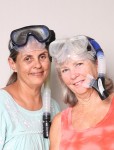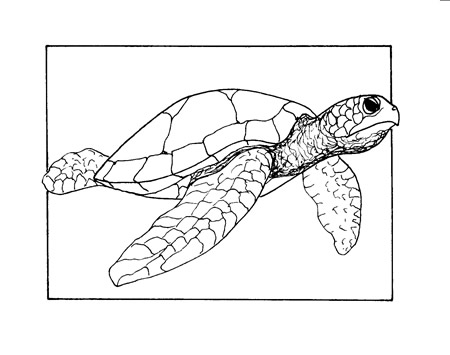Turtles Tell No Tales

In recent months, several local snorkelers, including us, have been getting the singular thrill of swimming with a sea turtle just off shore in Laguna. The turtles have been identified as the Pacific green sea turtle (Chelonia mydas), who although they have a worldwide population in tropical and subtropical waters, are considered endangered throughout their range and seldom seen in Laguna Beach.
With the exceptions noted below, the Pacific green turtle most commonly occurs south of San Diego with the nearest documented nesting sight located along the southern tip of Baja California Sur. Named for the green flesh found under their skin, they grow on average to four feet and more than 350 pounds. The carapace (shell) is made up of bony scutes (scales) that are flattened and irregularly colored in shades of black, brown, olive green and yellow often with algae growing upon it. Their undersides are light in color. Unable to retract their small and blunt head and flippers into the carapace, they are covered in thick, scaly, brownish colored skin. Believed to live to between 80 to 100 years, males are slightly larger than females.
Spending most of their time submerged in the ocean, the turtles are reptiles and require surfacing to breath oxygen. Adults are herbivores and spend much of their time in the shallows feeding on seagrass and algae. Reaching sexual maturity between 10 to 25 years, they will migrate thousands of miles every two to four years to return to their natal grounds (birthplace) to reproduce and nest. Internally fertilized, mating takes place in the water, and when ready to lay her eggs a few weeks later, the female will climb onto the beach at night to dig a hole in the sand to lay a clutch of over 100 eggs. After covering the eggs with sand, she will return to the sea. She can lay up to five clutches per breeding season. Incubating for about two months, the eggs all hatch at the same time and the two inch long hatchlings make a mad dash to the sea. Drifting off, the juveniles are omnivores eating plankton, jellies, worms and snails near the surface as they spend the next several years floating in the ocean currents.
Predation of green sea turtles varies during the different stages of their life. While in the nest, raccoons, coyotes and humans are a few of the species that eat the eggs. During their dash to the sea, they are eaten by birds and crabs. As juveniles, before their shells harden, fish and seabirds prey on them. Adults are preyed on by large sharks and are harvested as a food source by humans, unfortunately still legal in many countries. Classified as endangered on the IUCN Red list, turtle deaths result from fisheries bycatch, which is the incidental capture in nets (particularly shrimp trawlers), boat strikes, marine debris entanglement and oil pollution. The reduction of nesting habitat due to degradation and human development and lighting pollution, where artificial lighting is present to disorient the hatchlings so they never reach the ocean, are other reasons. Additionally, fibropapillomatosis, a disease characterized by lesions and tumors have been documented with increasing frequency on the green sea turtle. Although benign, the disease can hamper the eyes, the mouth and the flippers and ultimately cause the turtle’s death.
For the past 100 years, a resident population of green sea turtles have lived and foraged in the San Diego Bay, occasionally seen from La Jolla Shores to Northern San Diego. Since the mid-1980’s, a small resident green sea turtle population has been recorded at the mouth of the San Gabriel River in Long Beach near the outfall of two Long Beach power plants. Whether the turtle that was visiting Laguna came from either of these populations or from further afield is unknown. However should you ever come across this graceful creature, keep your distance and remain calm. If you are as lucky as we were, the turtle will approach and allow you to watch it for the next few minutes before swimming away.
Mia Davidson and artist Jan Sattler are long-time Laguna residents and year round ocean swimmers who believe that educating the public about the marine environment will contribute to preservation of the habitat and its organisms.





